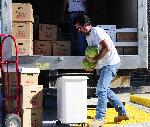COLUMBIA, Mo. – Rick Boudreau’s deliveries may seem ordinary, but the boxes of local produce he carries into Columbia elementary schools help students eat healthier.
For Shepard Boulevard Elementary School, that means local apples, tomatoes and melons from nearby farms will make the menu this fall for its students.
“Everything’s picked within 24 hours so they get the freshest product we can find,” said Boudreau, owner of Missouri Food 4 Missouri People. “Most farmers are good at growing, but that’s where it begins and ends, so I try to offer some of the other services they may not have to get their product moved.”
Boudreau works as a food broker, connecting area farmers with schools across central Missouri. The food travels less than 100 miles from the farmer’s field to the school kitchen.
The Farm to School movement is increasingly popular with students, school administrators and parents across the U.S. At least 78 districts in Missouri and more than 2,300 districts nationwide run Farm to School programs, according to the National Farm to School Network.
“It’s hard to compete against pizza, chicken nuggets and cheeseburgers, but we’ve noticed that – from kindergarten students to high schoolers – if something tastes good they are going to eat it,” said Lorin Fahrmeier, University of Missouri Extension Farm to School state coordinator. “The food is fresh, you know where it comes from and it keeps as many dollars as possible in your communities to support both your local schools and farmers.”
The road from farm to school
Boudreau says it’s hard work to get fresh produce to the network of schools.
The Boston native moved to Missouri six years ago with a dream to raise local produce. In 2009 he began his life as a food broker.
With help from MU Extension experts, Columbia Public Schools contracted with Boudreau in May 2010 and fresh, local produce started arriving at cafeterias.
“One of the myths of local foods is that it’s too expensive and too scarce,” Boudreau said. “Once we proved that there is plenty of it out there and it could be affordable if done right, it all started to fall into place.”
Now Boudreau works with a network of more than 20 produce farmers near towns like Prairie Home, Keytesville and La Plata. He provides services farmers usually can’t provide for themselves. That not only includes trucking the fruits and vegetables to schools in Columbia and Jefferson City, but also maintaining liability insurance and quality control of the product.
While produce farmers aren’t currently required to meet federal food safety standards, Boudreau mirrors the guidelines of Good Agricultural Practices (GAP), a voluntary federal certification program.
“Each case we deliver has a sticker on the top that lists the product, the date it was picked and a farmer ID number that can be traced back to the farm I picked it up from, so if there is a problem we can address it immediately.”
Boudreau takes that produce and makes 30 deliveries most days during the growing season.
But one size doesn’t fit all schools.
“This program is about making something work for your school, not completely changing the way school food service is done,” Fahrmeier said. “Lots of different models are happening. Some schools buy direct from a farmer who brings the produce right into the school. There are small produce brokers, and some large wholesale grocers buy local produce.”
You are what you eat
The real test for the program comes in the lunch line, and students voice their approval between bites.
“I like the tomatoes because when you bite into them, it’s like all those juices are bottled up like in an air balloon and when you pop it, it just explodes,” said Joseph Lee, a fifth-grade student at Shepard Elementary.
Students aren’t the only ones who approve.
Laina Fullum, director of nutrition services at Columbia Public Schools, said she sees the program’s success in both students and staff.
“The kids are noticing the taste difference, staff are noticing the taste difference, and the modeling of behavior from staff helps children as well,” Fullum said. “What was really surprising was last spring when we served asparagus (our supplier) couldn’t keep it in stock because they had no idea that it would be such a hit.”
Boudreau notes that the program gives some students exposure to fruits and vegetables they never tried before.
“The children seem to be excited when the eggplant shows up. At their age I didn’t even know what an eggplant was,” he said. “It’s really good to see it’s catching on. Those kids are going to go home and say to parents, ‘I had this purple thing at school today. It was excellent. Can you go to the store and get me one?’”
Policy decisions are further bolstering Farm to School.
That groundswell of support is in part due to proposed changes to national school lunch standards that would require more fresh fruits, vegetables and whole grains at every meal while sharply reducing starches, fatty foods and sugar. The USDA is now sifting through more than 150,000 public comments that it will consider before making final revisions to the rules.
While the changes still need to be finalized, it is clear that school meals will contain more fruits and vegetables than before.
To accommodate these changes, Columbia Public Schools plans to consolidate production kitchens. By having five kitchens prepare fresh produce for all elementary schools, it hopes to maintain quality and do more cooking from scratch without increasing costs.
“Using fresh foods doesn’t necessarily have to be more expensive,” Fahrmeier said. “It’s about using the resources you already have, becoming more creative and maybe buying something like ‘number two’ tomatoes. Those might have a few dents and dings, but if you’re cutting them up it doesn’t necessarily have to look perfect because all you’re going for is the flavor.”
Larger districts can take cues from Columbia Public Schools. Many are moving toward consolidated kitchens to prepare all the fresh produce for an entire district.
Down the road, the health benefits should translate into economic benefits as well.
In 2009, more than 30 percent of Missouri’s population was classified as obese, including one in seven high schoolers, according to the Centers for Disease Control and Prevention. Meals that are more nutritious should mean fewer costly health problems associated with obesity, diabetes and other issues.
That makes Fullum confident about the decision to move away from easier meals to healthier food cooked from scratch for the 11,000 children the district feeds each day.
“We’re taking a risk by bringing raw products back into our kitchens, but if we do it in a controlled environment we can go back to scratch cooking to make it fresher, simpler and healthier so we don’t have to worry about what’s in our children’s food,” Fullum said. “That’s what parents want.”
Missouri Farm to School/Farm to Institution is a project of the Missouri Council for Activity and Nutrition and University of Missouri Extension that seeks to increase access to locally grown foods in order to strengthen the health, well-being and economic security of all communities and family farmers. Learn more at http://MofarmtoSchool.missouri.edu or http://MoFarmtoInstitution.missouri.edu.
This project is funded through a contract with the Missouri Department of Health and Senior Services and a grant from the U.S. Centers for Disease Control and Prevention.
Read more http://extension.missouri.edu/news/DisplayStory.aspx?N=1251






